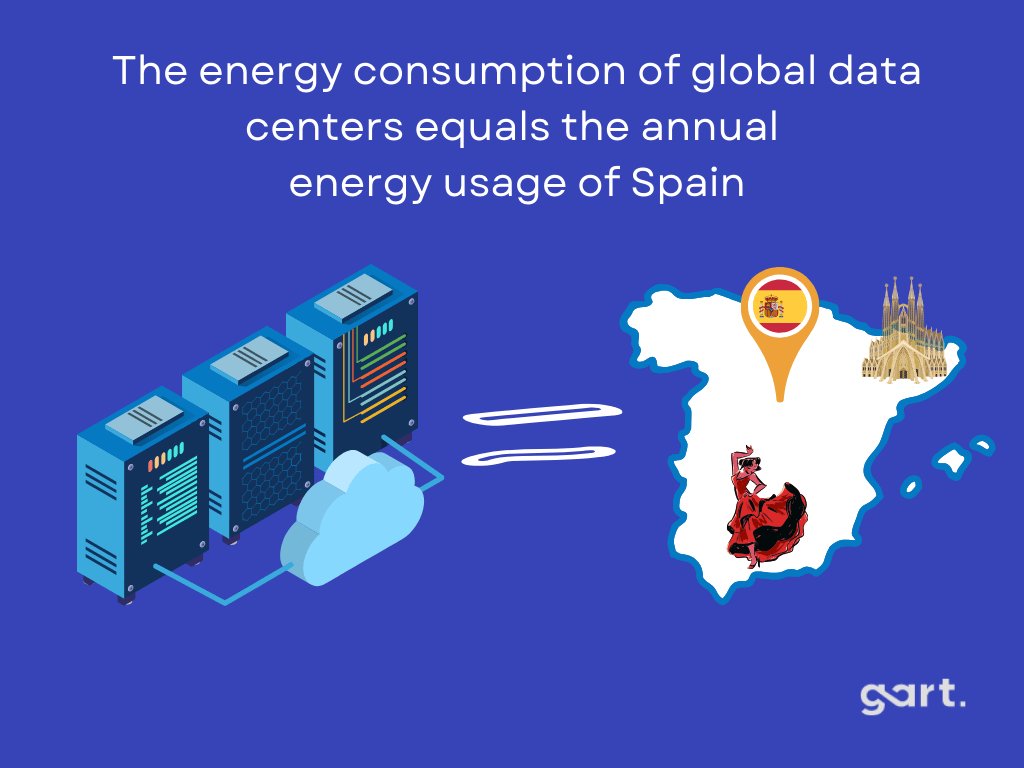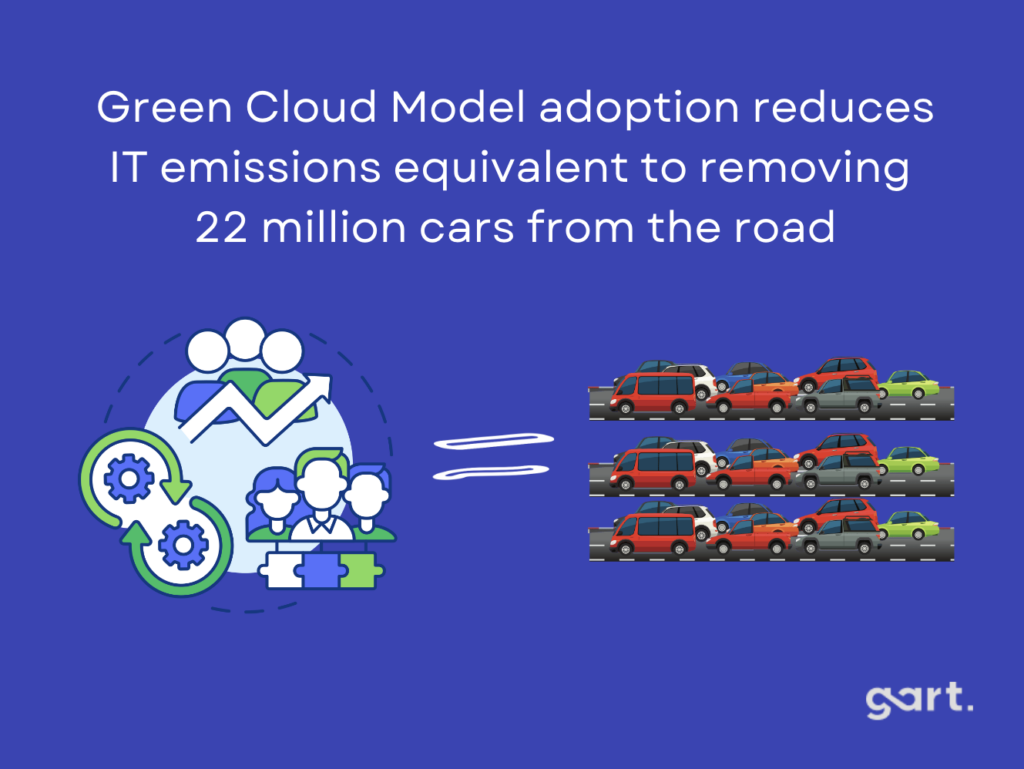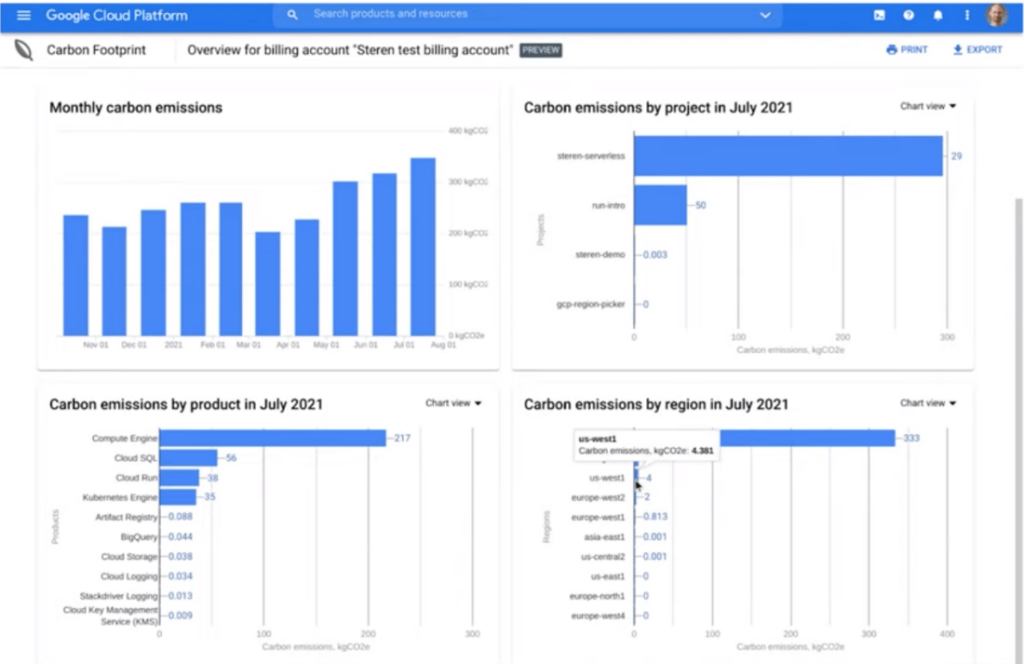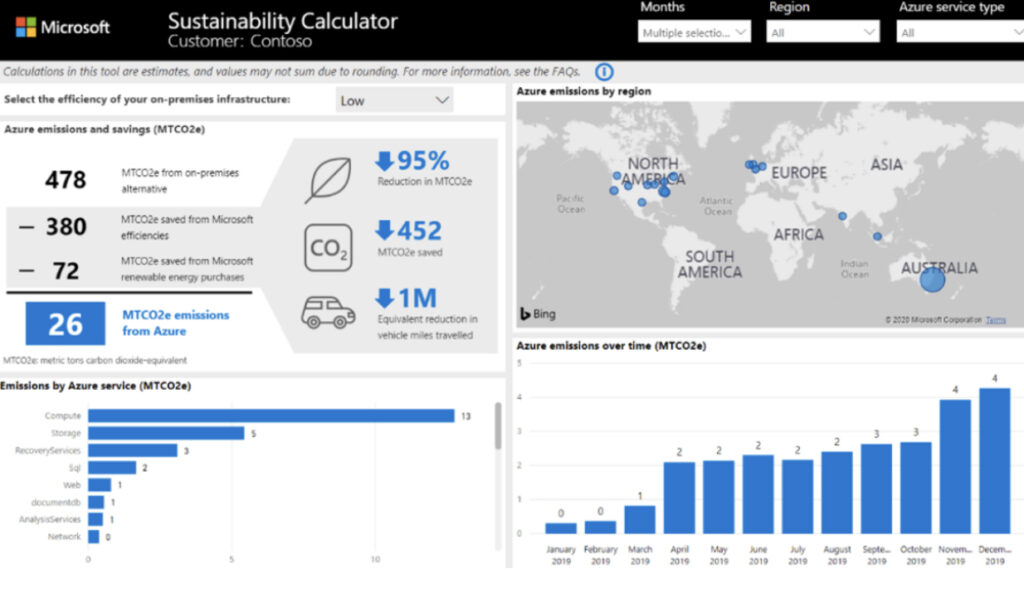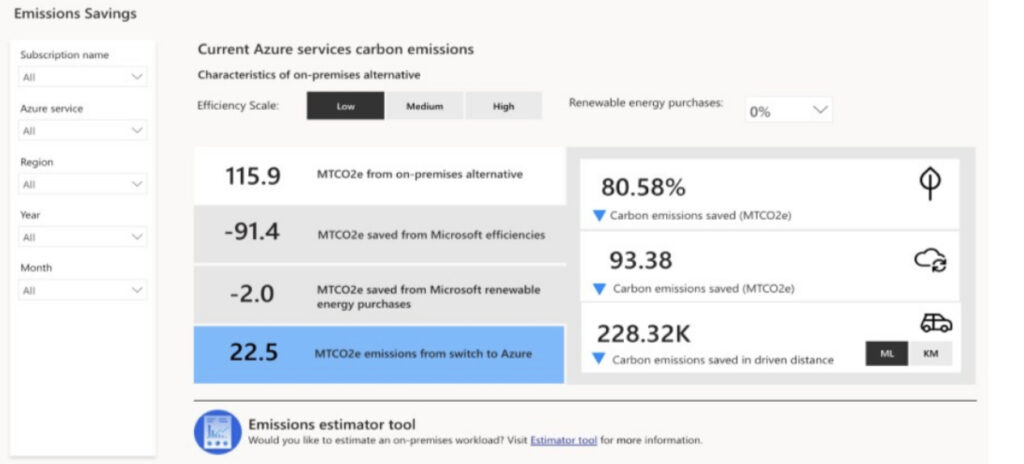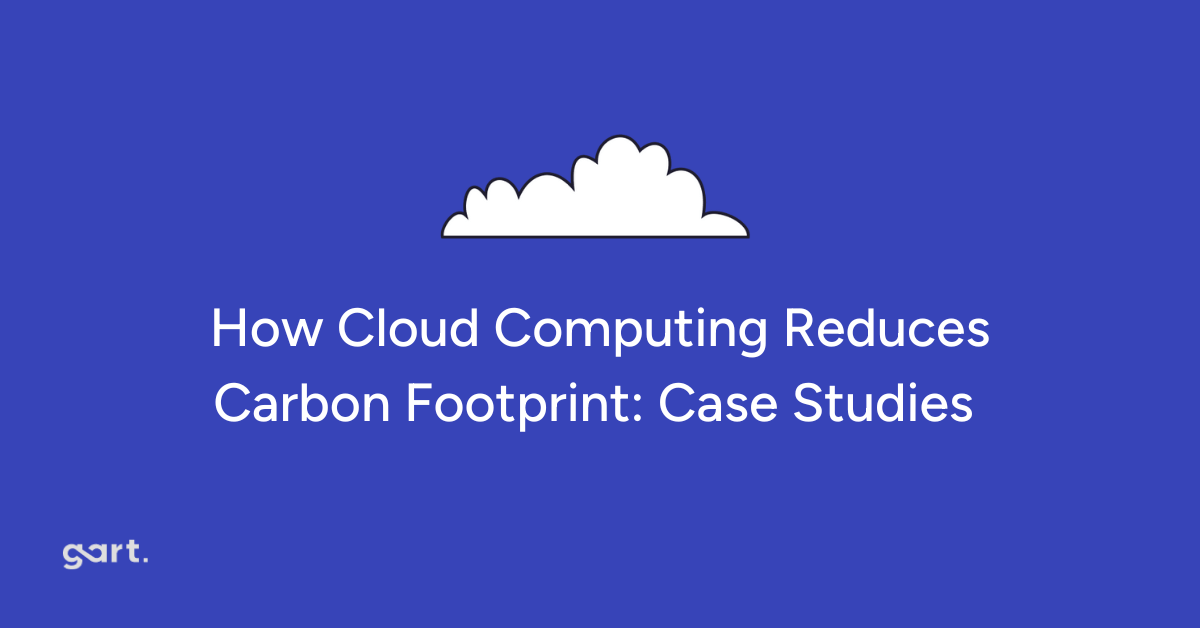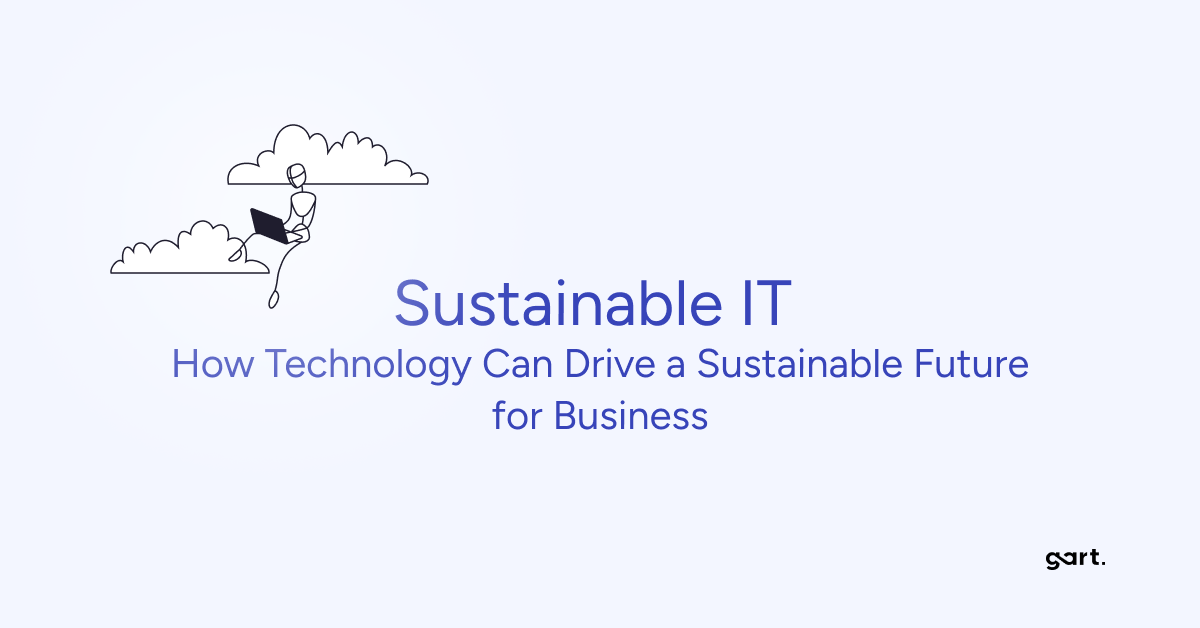
As climate change, resource depletion, and environmental issues loom large, businesses are turning to technology as a powerful ally in achieving their sustainability goals. This isn't just about saving the planet (although that's pretty important), it's also about creating a more efficient and resilient future for all.
Data is the new oil, and when it comes to sustainability, it's a game-changer. Technology empowers businesses to collect and analyze vast amounts of data, allowing them to make informed decisions about their environmental impact. By automating processes, streamlining operations, and enabling data-driven decision-making, businesses can minimize waste, reduce energy consumption, and optimize resource utilization.
Digital technologies, such as cloud computing, remote collaboration tools, and virtual platforms, have the potential to reduce the need for physical infrastructure and travel, thereby minimizing the associated environmental impacts.
One of the primary challenges is striking a balance between sustainability goals and profitability. Many businesses struggle to reconcile the perceived trade-off between environmental considerations and short-term financial gains. Implementing sustainable practices often requires upfront investments in new technologies, infrastructure, or processes, which can be costly and may not yield immediate returns. Convincing stakeholders and shareholders of the long-term benefits and value of sustainability can be a complex task.
The Environmental Impact of IT Infrastructure
One of the primary concerns regarding IT infrastructure is energy consumption. Data centers, which house servers, storage systems, and networking equipment, are energy-intensive facilities. They require substantial amounts of electricity to power and cool the hardware, contributing to greenhouse gas emissions and straining energy grids. According to estimates, data centers account for approximately 1% of global electricity consumption, and this figure is expected to rise as data volumes and computing demands continue to grow.
Furthermore, the manufacturing process of IT equipment, such as servers, computers, and other hardware components, involves the extraction and processing of raw materials, which can have detrimental effects on the environment. The mining of rare earth metals and other minerals used in electronic components can lead to habitat destruction, water pollution, and the depletion of natural resources.
E-waste, or electronic waste, is another pressing issue related to IT infrastructure. As technological devices become obsolete or reach the end of their lifecycle, they often end up in landfills or informal recycling facilities, posing risks to human health and the environment. E-waste can contain hazardous substances like lead, mercury, and cadmium, which can leach into soil and water sources, causing pollution and potential harm to ecosystems.
By addressing the environmental impact of IT infrastructure, businesses can not only reduce their carbon footprint and resource consumption but also contribute to a more sustainable future. Striking a balance between technological innovation and environmental stewardship is crucial for achieving long-term sustainability goals.
DevOps and Sustainability
DevOps practices play a pivotal role in optimizing resources and reducing waste, making them a powerful ally in the pursuit of sustainability. By seamlessly integrating development and operations processes, DevOps enables organizations to achieve greater efficiency, agility, and environmental responsibility.
At the core of DevOps is the principle of automation and continuous improvement. By automating repetitive tasks and streamlining processes, DevOps eliminates manual efforts, reduces human errors, and minimizes resource wastage. This efficiency translates into lower energy consumption, decreased hardware utilization, and a reduced carbon footprint.
CI/CD for Improved Eco-Efficiency
Continuous Integration and Continuous Delivery (CI/CD) are essential DevOps practices that contribute to sustainability. CI/CD enables organizations to rapidly and frequently deliver software updates and improvements, ensuring that applications run optimally and efficiently. This approach minimizes the need for resource-intensive deployments and reduces the overall environmental impact of software development and operations.
Moreover, CI/CD facilitates the early detection and resolution of issues, preventing potential inefficiencies and resource wastage. By integrating automated testing and quality assurance processes, organizations can identify and address performance bottlenecks, security vulnerabilities, and other issues that could lead to increased energy consumption or resource utilization.
Monitoring and Analytics for Identifying and Eliminating Inefficiencies
DevOps emphasizes the importance of monitoring and analytics as a means to gain insights into system performance, resource utilization, and potential areas for improvement. By leveraging advanced monitoring tools and techniques, organizations can gather real-time data on energy consumption, hardware utilization, and application performance.
This data can then be analyzed to identify inefficiencies, such as underutilized resources, redundant processes, or areas where optimization is required. Armed with these insights, organizations can take proactive measures to streamline operations, adjust resource allocation, and implement energy-saving strategies, ultimately reducing their environmental footprint.
For a deeper dive into how monitoring and analytics can drive efficiency and sustainability, explore this case study of a software development company that optimized its workload orchestration using continuous monitoring.
Our case study: Implementation of Nomad Cluster for Massively Parallel Computing
Cloud Computing and Sustainability
Cloud computing has emerged as a transformative technology that not only enhances efficiency and agility but also holds significant potential for promoting sustainability and reducing environmental impact. By leveraging the power of cloud services, organizations can achieve remarkable energy and resource savings, while simultaneously minimizing their carbon footprint.
Energy and Resource Savings through Cloud Services
One of the primary advantages of cloud computing in terms of sustainability is the efficient utilization of shared resources. Cloud service providers operate large-scale data centers that are designed for optimal resource allocation and energy efficiency. By consolidating workloads and leveraging economies of scale, cloud providers can maximize resource utilization, reducing energy consumption and minimizing waste.
Additionally, cloud providers invest heavily in implementing cutting-edge technologies and best practices for energy efficiency, such as advanced cooling systems, renewable energy sources, and efficient hardware. These efforts result in significant energy savings, translating into a lower carbon footprint for organizations that leverage cloud services.
Flexible Cloud Models for Cost Optimization for Sustainable Operations
Cloud computing offers flexible deployment models, including public, private, and hybrid clouds, allowing organizations to tailor their cloud strategies to meet their specific needs and optimize costs. By embracing the pay-as-you-go model of public clouds or implementing private clouds for sensitive workloads, businesses can dynamically scale their resource consumption, avoiding over-provisioning and minimizing unnecessary energy expenditure.
Cloud providers offer a diverse range of compute and storage resources with varying payment options and tiers, catering to different use cases and requirements. For instance, Amazon Web Services (AWS) provides Elastic Compute Cloud (EC2) instances with multiple pricing models, including Dedicated, On-Demand, Spot, and Reserved instances. Choosing the most suitable instance type for a specific workload can lead to significant cost savings.
Dedicated instances, while the most expensive option, are ideal for handling sensitive workloads where security and compliance are of paramount importance. These instances run on hardware dedicated solely to a single customer, ensuring heightened isolation and control.
On-demand instances, on the other hand, are billed on an hourly basis and are well-suited for applications with short-term, irregular workloads that cannot be interrupted. They are particularly useful during testing, development, and prototyping phases, offering flexibility and scalability on-demand.
For long-running workloads, Reserved instances offer substantial discounts, up to 72% compared to on-demand pricing. By investing in Reserved instances, businesses can secure capacity reservations and gain confidence in their ability to launch the required number of instances when needed.
Spot instances present a cost-effective alternative for workloads that do not require high availability. These instances leverage spare computing capacity, enabling businesses to benefit from discounts of up to 90% compared to on-demand pricing.
Our case study: Cutting Costs by 81%: Azure Spot VMs Drive Cost Efficiency for Jewelry AI Vision
Additionally, DevOps teams employ various cloud cost optimization practices to further reduce operational expenses and environmental impact. These include:
- Identifying and deleting underutilized instances
- Moving infrequently accessed storage to more cost-effective tiers
- Exploring alternative regions or availability zones with lower pricing
- Leveraging available discounts and pricing models
- Implementing spend monitoring and alert systems to track and control costs proactively
By adopting a strategic approach to resource utilization and cost optimization, businesses can not only achieve sustainable operations but also unlock significant cost savings. This proactive mindset aligns with the principles of environmental stewardship, enabling organizations to thrive while minimizing their ecological footprint.
Read more: Sustainable Solutions with AWS
Reduced Physical Infrastructure and Associated Emissions
Moving to the cloud isn't just about convenience and scalability – it's a game-changer for the environment. Here's why:
Bye-bye Bulky Servers
Cloud computing lets you ditch the on-site server farm. No more rows of whirring machines taking up space and guzzling energy. Cloud providers handle that, often in facilities optimized for efficiency. This translates to less energy used, fewer emissions produced, and a lighter physical footprint for your business.
Commuting? Not Today
Cloud-based tools enable remote work, which means fewer cars on the road spewing out emissions. Not only does this benefit the environment, but it also promotes a more flexible and potentially happier workforce.
Cloud computing offers a win-win for businesses and the planet. By sharing resources, utilizing energy-saving data centers, and adopting flexible deployment models, cloud computing empowers organizations to significantly reduce their environmental impact without sacrificing efficiency or agility. Think of it as a powerful tool for building a more sustainable future, one virtual server at a time.
Get a sample of IT Audit
Sign up now
Get on email
Loading...
Thank you!
You have successfully joined our subscriber list.
Effective Infrastructure Management and Sustainability
Effective infrastructure management plays a crucial role in achieving sustainability goals within an organization. By implementing strategies that optimize resource utilization, reduce energy consumption, and promote environmentally-friendly practices, businesses can significantly diminish their environmental impact while maintaining operational efficiency.
Virtualization and Consolidation Strategies for Reducing Hardware Needs
Virtualization technology has revolutionized the way organizations manage their IT infrastructure.
By ditching the extra servers, you're using less energy to power and cool them. Think of it like turning off all the lights in empty rooms – virtualization ensures you're only using the resources you truly need. This translates to significant energy savings and a smaller carbon footprint.
Fewer servers mean less hardware to manufacture and eventually dispose of. This reduces the environmental impact associated with both the production process and electronic waste (e-waste). Virtualization helps you be a more responsible citizen of the digital world.
Our case study: IoT Device Management Using Kubernetes
Optimizing with Third-Party Services
In the pursuit of sustainability and resource efficiency, businesses must explore innovative strategies that can streamline operations while reducing their environmental footprint. One such approach involves leveraging third-party services to optimize costs and minimize operational overhead. Cloud computing providers, such as Azure, AWS, and Google Cloud, offer a vast array of services that can significantly enhance the development process and reduce resource consumption.
A prime example is Amazon's Relational Database Service (RDS), a fully managed database solution that boasts advanced features like multi-regional setup, automated backups, monitoring, scalability, resilience, and reliability. Building and maintaining such a service in-house would not only be resource-intensive but also costly, both in terms of financial investment and environmental impact.
However, striking the right balance between leveraging third-party services and maintaining control over critical components is crucial. When crafting an infrastructure plan, DevOps teams meticulously analyze project requirements and assess the availability of relevant third-party services. Based on this analysis, recommendations are provided on when it's more efficient to utilize a managed service, and when it's more cost-effective and suitable to build and manage the service internally.
For ongoing projects, DevOps teams conduct comprehensive audits of existing infrastructure resources and services. If opportunities for cost optimization are identified, they propose adjustments or suggest integrating new services, taking into account the associated integration costs with the current setup. This proactive approach ensures that businesses continuously explore avenues for reducing their environmental footprint while maintaining operational efficiency.
One notable success story involves a client whose services were running on EC2 instances via the Elastic Container Service (ECS). After analyzing their usage patterns, peak periods, and management overhead, the DevOps team recommended transitioning to AWS Fargate, a serverless solution that eliminates the need for managing underlying server infrastructure. Fargate not only offered a more streamlined setup process but also facilitated significant cost savings for the client.
By judiciously adopting third-party services, businesses can reduce operational overhead, optimize resource utilization, and ultimately minimize their environmental impact. This approach aligns with the principles of sustainability, enabling organizations to achieve their goals while contributing to a greener future.
Our case study: Deployment of a Node.js and React App to AWS with ECS
Green Code and DevOps Go Hand-in-Hand
At the heart of this sustainable approach lies green code, the practice of developing and deploying software with a focus on minimizing its environmental impact. Green code prioritizes efficient algorithms, optimized data structures, and resource-conscious coding practices.
At its core, Green Code is about designing and implementing software solutions that consume fewer computational resources, such as CPU cycles, memory, and energy. By optimizing code for efficiency, developers can reduce the energy consumption and carbon footprint associated with running applications on servers, desktops, and mobile devices.
Continuous Monitoring and Feedback
DevOps promotes continuous monitoring of applications, providing valuable insights into resource utilization. These insights can be used to identify areas for code optimization, ensuring applications run efficiently and consume less energy.
Infrastructure Automation:
Automating infrastructure provisioning and management through tools like Infrastructure as Code (IaC) helps eliminate unnecessary resources and idle servers. Think of it like switching off the lights in an empty room – automation ensures resources are only used when needed.
Containerization
Containerization technologies like Docker package applications with all their dependencies, allowing them to run efficiently on any system. This reduces the need for multiple servers and lowers overall energy consumption.
Cloud-Native Development
By leveraging cloud platforms, developers can benefit from pre-built, scalable infrastructure with high energy efficiency. Cloud providers are constantly optimizing their data centers for sustainability, so you don't have to shoulder the burden alone.
DevOps practices not only streamline development and deployment processes, but also create a culture of resource awareness and optimization. This, combined with green code principles, paves the way for building applications that are not just powerful, but also environmentally responsible.
How Businesses Are Using DevOps, Cloud, and Green Code to Thrive
Case Study 1: Transforming a Local Landfill Solution into a Global Platform
ReSource International, an Icelandic environmental solutions company, developed elandfill.io, a digital platform for monitoring and managing landfill operations. However, scaling the platform globally posed challenges in managing various components, including geospatial data processing, real-time data analysis, and module integration.
Gart Solutions implemented the RMF, a suite of tools and approaches designed to facilitate the deployment of powerful digital solutions for landfill management globally.
Case Study 3: The #1 Music Promotion Services Cuts Costs with Sustainable AWS Solutions
The #1 Music Promotion Services, a company helping independent artists, faced rising AWS infrastructure costs due to rapid growth. A multi-faceted approach focused on optimization and cost-saving strategies was implemented. This included:
Amazon SNS Optimization: A usage audit identified redundant notifications and opportunities for batching messages, leading to lower usage charges.
EC2 and RDS Cost Management: Right-sizing instances, utilizing reserved instances, and implementing auto-scaling ensured efficient resource utilization.
Storage Optimization: Lifecycle policies and data cleanup practices reduced storage costs.
Traffic and Data Transfer Management: Optimized data transfer routes and cost monitoring with alerts helped manage unexpected spikes.
Results: Monthly AWS costs were slashed by 54%, with significant savings across services like Amazon SNS and EC2/RDS. They also established a framework for sustainable cost management, ensuring long-term efficiency.
Partner with Gart for IT Cost Optimization and Sustainable Business
As businesses strive for sustainability, partnering with the right IT provider is crucial for optimizing costs and minimizing environmental impact. Gart emerges as a trusted partner, offering expertise in cloud computing, DevOps, and sustainable IT solutions.
Gart's cloud proficiency spans on-premise-to-cloud migration, cloud-to-cloud migration, and multi-cloud/hybrid cloud management. Our DevOps services include cloud adoption, CI/CD streamlining, security management, and firewall-as-a-service, enabling process automation and operational efficiencies.
Recognized by IAOP, GSA, Inc. 5000, and Clutch.co, Gart adheres to PCI DSS, ISO 9001, ISO 27001, and GDPR standards, ensuring quality, security, and data protection.
By partnering with Gart, businesses can optimize IT costs, reduce their carbon footprint, and foster a sustainable future. Leverage Gart's expertise to align your IT strategies with environmental goals and unlock the benefits of cost optimization and sustainability.
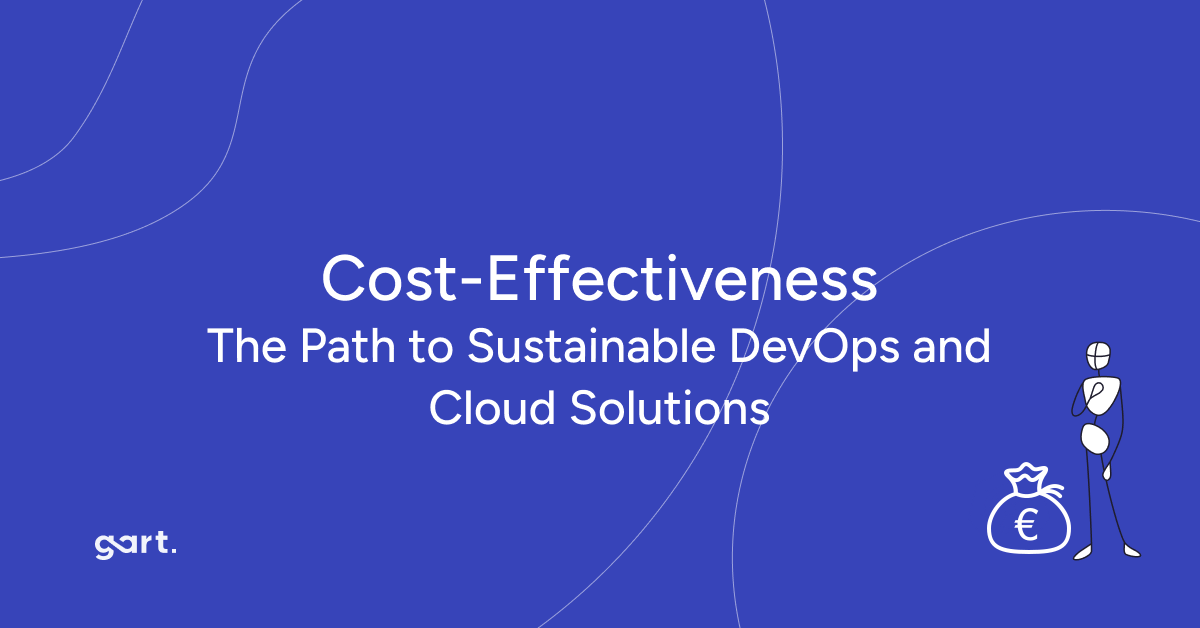
Cost-effectiveness in DevOps and cloud strategy isn’t about finding the cheapest provider — it's about building scalable, sustainable, and efficient systems that reduce total cost of ownership while supporting long-term business growth.
What Does Cost-Effectiveness Mean in DevOps and Cloud?
Cost-effectiveness in this context refers to balancing investment with long-term value, not cutting corners. Instead of opting for the cheapest service or tool available, it’s about making strategic decisions that improve performance, reliability, and scalability over time.
Too often, organizations assume cutting IT spend or chasing free cloud credits is “efficient.” But this can backfire when hidden costs, performance bottlenecks, or non-scalable infrastructure come into play.
Why the Cheapest Option Isn’t Always the Best Long-Term Choice
There are cloud startup programs, but it's essential to approach them carefully. Often, businesses make mistakes in network design and services while using free cloud credits, leading to significant additional infrastructure costs once the free period ends.
One startup leveraged free credits from the Google Cloud Startup Program to quickly build its product. However, when the free period ended, they faced crippling infrastructure costs due to a lack of optimization. Check this case study: DevOps for Microsoft HoloLens Application Run on GCP
Summary:
Choosing the lowest-cost IT or cloud option often leads to technical debt, downtime, and scalability issues, costing more in the long run.
While it's tempting to lean into "free tiers" and minimal upfront expenses, these choices frequently come with hidden costs:
Limited functionality
Lack of support or SLAs
High overage charges after trial periods end
At Gart Solutions, we promote a sustainable approach that maximizes ROI while aligning with business goals, ensuring that every IT dollar contributes to performance, stability, and growth.
Sustainable IT Cost Reductions vs. Short-Term Cuts
Summary:
Cutting costs for immediate savings often leads to long-term inefficiencies. True cost-effectiveness means aligning IT spending with business strategy and future-readiness.
In economic downturns, it’s natural for CIOs and IT leaders to seek cost savings. But reckless budget slashing can do more harm than good.
Avoid These 3 Common Mistakes:
Short-term focus: Cutting across the board can hinder future growth and innovation.
Overreliance on consultants: Consultants often suggest low-hanging fruit, leaving limited potential for long-term savings.
Neglecting stakeholders: Ignoring the impact of IT cuts on business operations can damage relationships and hinder outcomes.
Our Strategy for Cost-Effective DevOps and Cloud Solutions
Summary:
We combine smart savings with strategic investments, helping clients avoid over-engineering while investing wisely in scalable, future-ready infrastructure.
Not every component of your infrastructure needs premium tools or enterprise licenses. At Gart Solutions, we guide clients through intelligent decision-making:
Where to optimize for cost (e.g., Spot VMs, autoscaling, open-source tools)
Where to invest for growth (e.g., security, automation, compliance tooling)
Our goal: make sure every dollar contributes to uptime, user experience, or innovation.
By carefully analyzing your needs and implementing smart strategies, we ensure that you're getting the most out of your IT investments. This approach not only reduces waste but also ensures that every dollar spent contributes directly to your business goals.
Read more: 20 Easy Ways to Optimize Expenses on AWS and Save Over 80% of Your Budget
Strategic Product Design as a Foundation for Cost Savings
The cornerstone of our cost-effective approach is strategic product design. We focus on laying down the right basic architecture from the start, emphasizing long-term stability and scalability. This ensures that your IT solutions can adapt and grow with your business without encountering major issues or requiring extensive reworks.
Our solutions are designed with your future in mind. We create systems that can scale seamlessly as your business grows, allowing you to manage costs effectively at every stage of your journey. One of the key benefits of our approach is the ability to avoid future technological problems related to growth, migration, or other common challenges.
This forward-thinking approach prevents the need for costly overhauls down the line and provides a stable foundation for your ongoing success.
Case Study: Azure Spot VMs for Jewelry AI Vision
In one example, we helped a visual AI platform for the jewelry industry cut cloud costs by 81% using Azure Spot VMs. By redesigning workloads for elasticity and resilience, we optimized compute consumption without compromising performance.
Lesson: Design choices made early unlock compounding savings over time.
Check this cost optimization case study: Cutting Costs by 81%: Azure Spot VMs Drive Cost Efficiency for Jewelry AI Vision.
Get a sample of IT Audit
Sign up now
Get on email
Loading...
Thank you!
You have successfully joined our subscriber list.
Understanding Cloud Costs in DevOps: OpEx vs. CapEx
Summary:
DevOps-related cloud costs fall into two main categories: Operational Expenses (OpEx) and Capital Expenses (CapEx). Knowing the difference helps you budget and optimize more effectively.
Operational Expenses (OpEx)
OpEx refers to ongoing costs of running DevOps workloads in the cloud, such as:
Cloud instance runtime (compute)
Storage usage
Managed services (like databases or monitoring tools)
Traffic and bandwidth
These costs are typically pay-as-you-go and vary month-to-month.
Capital Expenses (CapEx)
CapEx refers to one-time or upfront investments, such as:
Reserved cloud capacity (e.g., AWS Reserved Instances)
On-premise infrastructure purchases
Software licenses or setup fees
Choosing CapEx can reduce monthly spending, but it requires commitment and forecasting.
What is FinOps and Why Does It Matter in Cost Optimization
Summary:
FinOps (Financial Operations) is a framework that brings financial discipline into DevOps, ensuring cloud spending is aligned with business value and usage.
Defining FinOps in Simple Terms
FinOps helps teams:
Understand where cloud dollars are going
Predict costs before deploying
Optimize spend without stalling innovation
It's the bridge between engineering, finance, and operations.
Why FinOps is a Game-Changer
In traditional IT, budgets are fixed. But in the cloud, expenses are variable and usage-driven. That makes cost control harder, unless teams actively manage and monitor costs.
FinOps brings visibility and accountability across:
Engineers (who build infrastructure)
Finance teams (who manage budgets)
Product managers (who track business value)
Key FinOps Practices:
Real-time cloud cost reporting
Cost forecasting by team/project
Tagging resources for accountability
Optimization sprints focused on spend reduction.
FinOps, or Financial Operations, is an evolving cloud financial management discipline that brings financial accountability to the variable spend model of cloud, enabling distributed teams to make business trade-offs between speed, cost, and quality.
How We Integrate FinOps Into Our DevOps Services
At Gart Solutions, we bake FinOps principles directly into our DevOps pipelines, so clients gain both infrastructure automation and cost control from day one.
Our FinOps Integration Approach Includes:
Cloud cost dashboards visible to stakeholders
Automated alerts for budget thresholds
Resource tagging and cost attribution per environment
Collaboration between engineers and finance on priorities
At Gart Solutions, we integrate FinOps practices into our DevOps and cloud services to further enhance cost-effectiveness and sustainability.
Case Studies: Cost-Effective DevOps in Action
Case Study 1: DevOps for Microsoft HoloLens Application on GCP
Challenge:A startup used Google Cloud's free startup credits to launch an ambitious product. But when the credits expired, they faced massive costs due to inefficient network design and a lack of resource planning.
Solution:Gart audited the infrastructure, implemented CI/CD pipelines, and restructured the architecture to reduce dependency on costly services.
Outcome:
48% reduction in monthly infrastructure spend
Improved performance and deployment speed
A scalable setup ready for product launch
Lesson:Free credits can create hidden risks. A strategic DevOps partner can turn short-term wins into sustainable growth.
Case Study 2: Cutting 81% Cloud Costs with Azure Spot VMs for AI Vision
Challenge:A jewelry AI startup faced high compute bills due to heavy visual processing and machine learning workloads.
Solution:Gart moved workloads to Azure Spot VMs, refactored pipelines for fault tolerance, and automated cost monitoring.
Outcome:
81% reduction in compute costs
Zero downtime during migration
Flexible scaling for future growth
Lesson:Cost savings don’t require cutting features, just smart architecture.
Long-Term Benefits of a Cost-Effective DevOps Strategy
Summary:
Sustainable DevOps isn’t just about saving money now. It helps your business scale smarter, reduce risk, and outperform competitors over time.
1. Lower Total Cost of Ownership (TCO)
You avoid patchwork fixes, re-platforming, and costly downtime. Efficient systems cost less to operate over years, not just months.
2. Greater Reliability
Fewer outages. Better performance. Happier users. And less stress for your team.
3. Future-Proof Architecture
With scalable infrastructure, your systems evolve with your needs, not against them.
4. Better Use of Internal Resources
Your team focuses on innovation instead of fixing things or firefighting budget issues.
DevOps Cost Decision Table – Cheap vs Sustainable
Understanding the difference between cost-cutting and cost-effectiveness is key. Here’s a side-by-side comparison that outlines why strategic investment outperforms bargain-basement decisions over time.
CriteriaCheap DevOps SolutionSustainable DevOps SolutionInitial CostLow upfront spendModerate, aligned with needs and future goalsScalabilityPoor – requires rebuildBuilt to scaleCompliance ReadinessLacks safeguardsAligned with HIPAA, GDPR, etc.Maintenance & SupportLimited or absentIncluded, proactive monitoringTotal Cost Over 12–24 MonthsHigh due to technical debt and reworkLower due to long-term savingsBusiness ImpactRisk of downtime, slower innovationFaster delivery, greater stability
Conclusion:The sustainable path pays off — not just financially, but in operational resilience, scalability, and growth enablement.
Cost Optimization Checklist for IT Leaders
Use this checklist to review your DevOps and cloud setup for waste, inefficiencies, and untapped savings.
✅ Infrastructure & Cloud Usage
Are we using reserved instances or spot pricing effectively?
Are workloads appropriately sized and scheduled?
Are we auto-scaling based on demand?
✅ Monitoring & Observability
Do we track cloud costs by team or project?
Are alert thresholds in place for spending anomalies?
Are we logging usage by service tags?
✅ DevOps & Automation
Are pipelines automated to prevent manual errors?
Are we deploying only what’s needed with IaC?
Are environments automatically shut down when idle?
✅ FinOps & Financial Governance
Do we review cloud spend weekly or monthly?
Are budgets and forecasts visible to Dev and Finance?
Have we assigned ownership for each cloud resource?
Conclusion
Sustainable DevOps isn't about spending less — it’s about spending smarter. At Gart Solutions, we believe that true cost-effectiveness is about creating sustainable, high-quality solutions that provide long-term value. By focusing on strategic design, smart resource utilization, and future-proofing your systems, we help you build a robust IT infrastructure that supports your business goals while keeping costs under control.
At Gart Solutions, our mission is to help you achieve IT sustainability and financial efficiency together.
Let’s build something that lasts, without overextending your budget.
Remember, indiscriminate cost-cutting can do more harm than good. A well-planned approach focused on long-term value is key to achieving sustainable IT cost reductions.
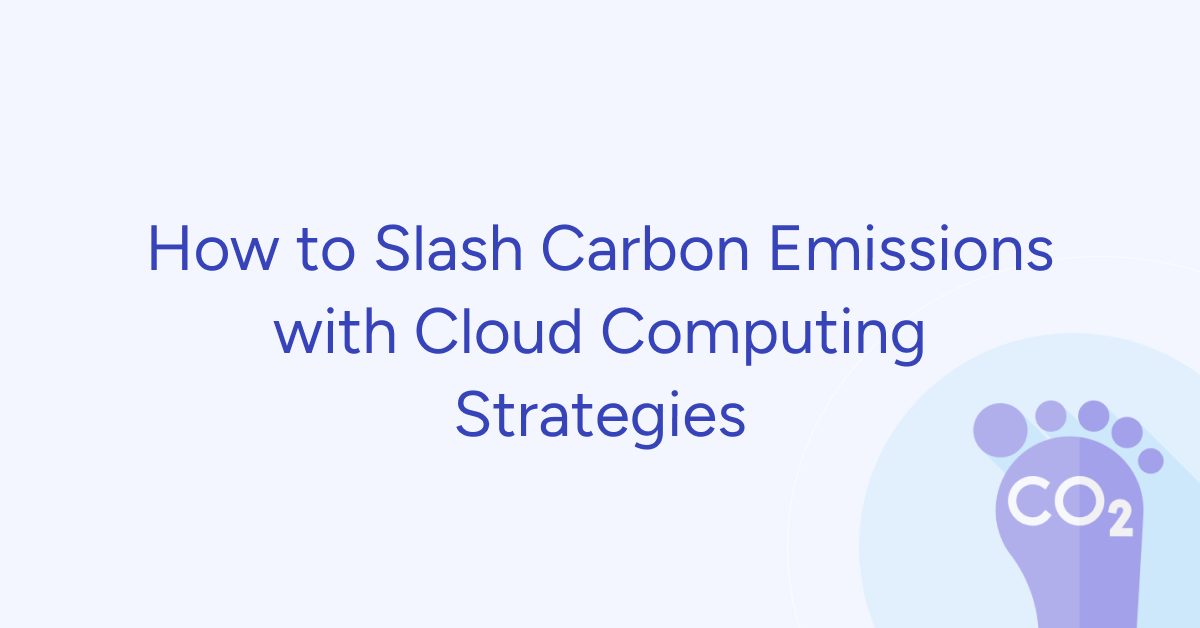
If you're thinking about moving your operations to the public cloud, you probably know about the benefits like improved agility, better performance, and lower costs. But there's one more important factor to think about: being eco-friendly.
When we look at how much energy global data centers use, it's almost as much as Spain uses in a whole year. Moving towards a green cloud model could make a big difference by reducing global CO2 emissions. This shift could cut total IT emissions by 5.9%, which is like taking 22 million cars off the road.
Why it Matters for Businesses
Carbon footprint refers to the total amount of greenhouse gases, specifically carbon dioxide (CO2) and other carbon compounds, that are released into the atmosphere as a result of human activities. This measurement is usually expressed in equivalent tons of CO2 emitted.
In July 2023, we experienced one of the hottest months in about 120,000 years. This highlights the pressing need to tackle climate change. As consumer habits change in response to these challenges, the demand for eco-friendly products and services is skyrocketing.
The tech industry is heading towards cutting ties with data centers powered by fossil fuels. To stay ahead in the market and maintain the trust of customers and investors, companies must act now to reduce their environmental impact. This can involve making smart choices about their cloud provider or even making significant changes themselves.
The good news is that major cloud providers not only offer solutions for your immediate needs but can also be a great starting point for your journey toward sustainable software development.
Embracing cloud solutions boosts sustainability and brings notable cost savings to organizations. Cloud providers offer scalable and pay-as-you-go models, enabling businesses to optimize resource use and cut operational costs.
The Environmental Impact of Cloud Computing
Energy Consumption and Carbon Emissions
Traditional cloud data centers, composed of extensive server farms, consume vast amounts of electricity. These centers often rely on fossil fuels, exacerbating greenhouse gas emissions. Reports suggest that the energy used by data centers worldwide accounts for approximately 1% of global electricity consumption, with this figure expected to rise.
Cooling Systems: A significant portion of energy usage in these data centers is attributed to cooling systems, which regulate server temperatures.
Carbon Footprint: The reliance on non-renewable energy sources amplifies the environmental toll, contributing significantly to climate change.
Resource Depletion and E-Waste
Beyond energy concerns, the manufacturing and decommissioning of hardware lead to resource depletion and electronic waste (e-waste). An estimated 50 million tons of e-waste are generated globally each year, highlighting the urgency for sustainable lifecycle management of cloud infrastructure.
Water Usage
Data centers also consume substantial amounts of water for cooling, which places stress on local water resources, further exacerbating their environmental footprint.
Why Cloud is More Affordable
Cloud computing transforms the landscape of IT services, moving away from traditional desktop setups to remote data centers. Users can effortlessly access on-demand infrastructure, eliminating the need for on-site installation and maintenance.
Green cloud computing takes this concept a step further by utilizing renewable energy sources, reducing energy consumption, and making a significant dent in the carbon footprint.
Virtualization and containerization, dividing hardware for deploying multiple operating systems, help reduce server needs and energy consumption. AI-based resource scheduling, guided by historical usage data, conserves energy. Infrastructure as a Service (IaaS) optimization, focusing on virtual machines and containers, contributes to eco-conscious IT.
A notable 2020 study revealed an interesting trend: despite a 550% increase in computing output, data center energy consumption only grew by 6%. This underscores the efficiency achieved through sustainable practices in cloud computing.
Ready to embrace the benefits of cloud migration? Contact Gart today, and let us guide you through a seamless transition to the cloud. The time is now to elevate your operations and embrace the future of digital efficiency.
Strategies for Sustainable Cloud Computing
Advanced Cooling Technologies
Innovations such as liquid cooling and precision air conditioning can significantly reduce the energy consumption associated with traditional cooling methods.
Server Virtualization
By enabling multiple virtual servers to run on a single physical machine, server virtualization minimizes hardware requirements, leading to lower energy consumption.
Renewable Energy Integration
Adopting renewable energy sources like solar, wind, and hydropower can dramatically cut down carbon emissions. Companies such as Google and Microsoft have committed to sourcing 100% renewable energy for their data centers, setting a precedent for others in the industry.
Dynamic Resource Allocation
Dynamic resource allocation ensures optimal server utilization by redistributing workloads based on real-time demand, reducing idle energy consumption.
A Closer Look at Each Cloud
In a world where the demand for environmentally-friendly businesses is growing, it's essential to be wary of greenwashing—superficial claims without real actions. When seeking vendors, prioritize those who openly share their sustainability efforts and show tangible results. Analyzing these details safeguards against false promises and ensures genuine steps toward a greener future receive support.
Top cloud service providers—Google, Amazon, and Microsoft—are actively committed to becoming carbon-neutral and transitioning their data centers to fully sustainable hosting by 2030.
The efficiency of public cloud infrastructure surpasses that of on-premises data centers, with a strong focus on adopting green energy sources.
AWS aims for 100% renewable energy by 2025 and net-zero emissions by 2040.
Azure plans to use 100% renewable energy by 2025 and strives to be carbon negative by 2030.
GCP is set to rely on 100% carbon-free energy by 2030.
Choosing these providers aligns with the pursuit of a sustainable and eco-friendly digital landscape.
Don't miss the opportunity to transform your operations. Contact Gart now, and let's initiate your seamless transition to the cloud—where innovation meets sustainability.
Google: Carbon-Free Operations, Water Conservation, and Cloud Sustainability
Google aims to power all its global operations with 100% carbon-free energy around the clock by 2030. They achieved carbon-neutrality in 2007 and have been using renewable energy for their data centers since 2017.
The company invests in technology for carbon removal solutions to offset its emissions. Google also has a goal to replenish 120% of the water consumed in its data centers and facilities.
Public cloud services, like Google's, rely on energy-efficient hyperscale data centers. These centers outperform smaller servers thanks to innovative infrastructure design and advanced cooling tech. Operating in a Google data center reduces electricity needs for IT hardware, leading to higher power usage effectiveness (PUE) compared to typical enterprise data centers.
Google Cloud not only prioritizes sustainability in its operations but also offers the Carbon Footprint tool for customers. This tool allows users to monitor and measure carbon emissions from their cloud applications, covering Scope 1, 2, and 3. It serves as an emissions calculator, aiding companies in reporting their gross carbon footprint and offering best practices for building low-carbon applications in Google Cloud.
Read more: Google Cloud Migration Services
Microsoft: Pioneering Carbon Reduction, Circular Solutions, and Cloud Sustainability
Microsoft aims to cut carbon emissions by over 50% by 2030 and eliminate its historical carbon footprint by 2050. They're shifting to 100% renewable energy for data centers and buildings by 2025, and zero waste is on the agenda by 2030.
Circular Centers repurpose old servers to combat growing e-waste, introduced as part of Microsoft's sustainability strategy since 2020.
Tools like Microsoft Cloud for Sustainability offer real-time insights into carbon emissions, while the Emissions Impact Dashboard for Microsoft 365 calculates cloud workload footprints.
Microsoft's focus areas include lowering energy consumption, green data centers, water management, and waste reduction through responsible sourcing and recycling.
Four key drivers reduce the energy and carbon footprint of the Microsoft Cloud: IT operational efficiency, equipment efficiency, datacenter infrastructure efficiency, and new renewable electricity, targeting 100% by 2025.
Read more: Azure Migration Services
Amazon: Leading the Charge with Net-Zero Commitment and Sustainable Solutions
As a co-founder of The Climate Pledge, Amazon joins 400 global companies committed to achieving net-zero carbon emissions by 2040. Their strategies include reducing material usage, innovating for energy efficiency, and embracing renewable energy solutions.
Amazon, the largest corporate buyer of renewable energy since 2020, leads in sustainable practices to decarbonize its transportation network.
A study by 451 Research found that US enterprises, on average, could cut their carbon footprint by up to 88% by moving to AWS from on-premises data centers.
Amazon introduces the AWS Customer Carbon Footprint Tool, an emissions calculator for customers. It provides data on carbon footprint, including Scope 1 and Scope 2 emissions from cloud service usage. It also estimates the carbon emission reduction achieved by transitioning operations to the cloud.
Read more: AWS Migration Services
Conceptual Frameworks for Green Clouds
There are several frameworks that provide a structured roadmap for sustainable cloud computing:
Ecological Modernization Theory
Triple Bottom Line (TBL)
Life Cycle Assessment (LCA)
Ecological Modernization Theory
Ecological Modernization Theory (EMT) emphasizes that technological advancement, rather than being a threat to the environment, can align with ecological objectives. The framework promotes leveraging innovation to minimize environmental impact while maintaining or enhancing efficiency.
In cloud infrastructures, this theory supports the integration of eco-friendly practices such as:
Adoption of energy-efficient hardware.
Investment in advanced cooling systems.
Use of renewable energy sources for powering data centers.
Cloud service providers can modernize their operations to reduce energy consumption and carbon footprints while maintaining service quality and scalability.
Triple Bottom Line (TBL)
The TBL framework evaluates sustainability across three dimensions: economic, social, and environmental. In the context of cloud computing, it offers a balanced perspective to achieve sustainability goals:
Economic Dimension: Ensures the financial viability of sustainable practices, such as reducing operational costs through energy-efficient technologies.
Social Dimension: Encourages corporate social responsibility by promoting awareness and equitable practices in communities where data centers operate.
Environmental Dimension: Prioritizes minimizing the ecological footprint through renewable energy integration, efficient resource usage, and e-waste management.
The TBL approach promotes a holistic view, ensuring that economic growth in the cloud industry does not come at the expense of environmental or social well-being.
Life Cycle Assessment (LCA)
LCA examines the environmental impact of cloud computing across its entire lifecycle, from raw material extraction to disposal. This detailed analysis helps identify the stages where intervention is most needed:
Stages in LCA:
Raw Material Extraction: Assessing the environmental costs of producing hardware components.
Manufacturing: Evaluating emissions and resource use during production.
Deployment and Operation: Measuring energy and water consumption during active use.
End-of-Life Management: Analyzing the ecological impact of decommissioning and recycling infrastructure components.
By understanding these stages, cloud providers can implement targeted strategies to mitigate the environmental impact, such as sourcing sustainable materials and adopting energy-efficient operations.
Empower Your Green Transition
Ready to take the leap into the public cloud? Before you dive in, a word of advice: Cloud migration is more than a simple "lift and shift." It requires a strategic approach, choosing the right vendor, ensuring infrastructure readiness, and aligning IT and business objectives.
However, the investment in this transition pays off. Shifting operations to the public cloud and prioritizing cloud-based applications can potentially reduce global emissions and energy consumption by up to 20 percent.
Feeling inspired to make a positive impact? Now's the time to act. Contact Gart, and we'll guide you through the migration process. Let's contribute to a greener future together!
